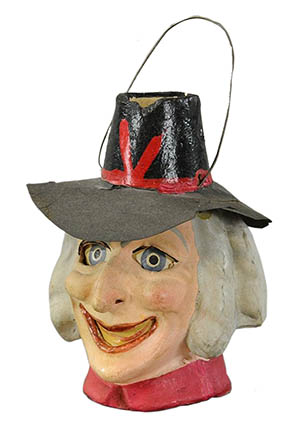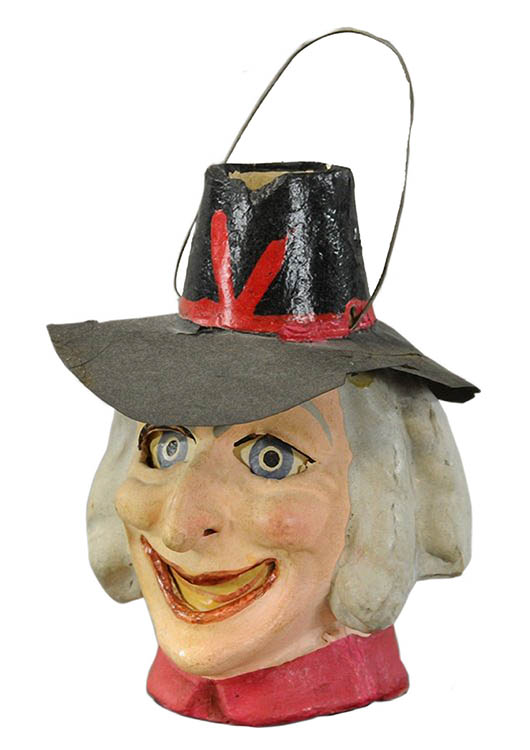
BEACHWOOD, Ohio – Halloween is the second most popular holiday among collectors of holiday memorabilia. Christmas comes first. But Halloween decorations are in such demand today that there are even mail-order catalogs and pop-up stores that feature nothing but Halloween. The idea behind Halloween goes back centuries, but the first Halloween parties that resembled modern celebrations of the holiday were costume parties for adults in the 1880s and 1890s. Costumes from those parties – some of the earliest Halloween collectibles – were almost always homemade.
Pressed-paper “veggie people,” jack-o’-lanterns and other Halloween decorations were being made by the 1900s, mostly in Germany. By the 1920s, jack-o’-lanterns were made of a composition material, holes were made for the eyes and mouth, and a hand-painted piece of paper was glued inside to create a finished face. By the 1950s Halloween decorations were being made of hard plastic, and in the 1990s a strange sponge-like plastic was popular for soft jack-o’-lanterns.
Pre-1950 Halloween memorabilia is scarce, so prices are high. But beware: Many reproductions of early paper jack-o’-lanterns and Halloween candy containers have been made in Japan. New mail order catalogs sell copies of old pieces along with new life-size witches, ghosts, skeletons and zombies, as well as tombstones, black cats and huge blow-up monsters and spiders. These too will be popular collectibles in a few years.
Q: I have a hand-stitched stuffed toy dog covered in a red felt-like material. It has a tag that says “Shaggy” and another tag that says “Stuffed Toys, Registration Number 1, Approved, Pennsylvania.” I’d like to know how old it is. I think Pennsylvania had a law that regulated what kind of stuffing could be used in plush toys, but I couldn’t find the date for that. Can you help?
A: Pennsylvania enacted a law regulating the manufacture of stuffed toys for retail sale in 1961, so your toy dog is less 53 years old. The law has been amended several times. It requires “All New Material” or “All New (Type) Material,” free from dangerous or harmful substances. It must meet flammability standards and the parts and decorations must be securely fastened. Manufacturers get a certificate of registration from the state after they meet the standards and pay a fee. The registration number must be shown on the toy.
Q: I’m 65 years old. When I was a child, my grandfather bought a Ross two-wheel bicycle for me. I’ve never seen one since then and wonder if the company is still in business.
A: Albert Ross founded Ross Galvanizing Works in 1940 in Brooklyn, N.Y. The company made pipes and fittings for fencing and military parts during World War II. It became Chain Bike Corp. in 1946, moved to Rockaway Beach in the 1950s, then to Allentown, Pa., in the 1970s. The company name became Ross Bicycles Inc. in 1982. It has been estimated that the company made over 15 million bicycles before it went bankrupt in 1989. The name “Ross” was bought by Rand Cycles of Farmingdale, N.Y. Rand made Ross children’s bicycles in Asia for a few years, then discontinued the bicycle brand.
Q: I have a small oil lamp that was used in our two-generation family home in rural Illinois. My family owned the home from 1867 to 1950. The lamp has an amber glass base embossed “Wide Awake.” It’s 9 inches tall and 3 inches wide at the base, which has a finger handle. The acorn burner is brass and the chimney is clear glass. Please share its history and value.
A: Miniature finger lamps like yours often were called “night lamps” or “night lights.” The name “Wide Awake” was one of many given to these small lamps. They were sold in the United States between about 1875 and the early 1900s. A “Wide Awake” lamp with a cobalt-blue base sold for $184 earlier this year.
Q: Years ago, I was given an armless rocking chair by a friend. The seat is upholstered and the back has a vase-shaped splat. A label on the bottom reads, “Brumby Chairs, Since 1875, The Brumby Chair Co., Marietta, Ga.” It’s not in the greatest condition, but I’m wondering what the chair is worth.
A: Brumby Chair Co. still is in business in Georgia. It is best known for its “Jumbo Rocker,” a large rocking armchair with a hand-caned seat and back. The company sells a new Jumbo Rocker for $995. Your chair, in a less-desirable style and in less than perfect condition, would sell as a used piece of furniture. You might get $20 to $40 for it.
Q: My large fancy perfume bottle is labeled “Uninhibited” and “Cher.” It has never been opened and is nearly a foot tall. Age? Price?
A: Cher’s “Uninhibited” perfume was marketed from about 1988 to 1998. Your bottle is called a “factice,” the word for a perfume display bottle set on a store’s countertop. A full Cher factice in mint condition, like yours, sells for about $125.
Tip: Don’t sticky-tape a top on a teapot. The decoration may come off with the tape. Secure a top with dental wax or earthquake wax.
Take advantage of a free listing for your group to announce events or to find antique shows, national meetings and other events. Go to the Calendar at Kovels.com to find, publicize and plan your antiquing trips.
Terry Kovel and Kim Kovel answer questions sent to the column. By sending a letter with a question, you give full permission for use in the column or any other Kovel forum. Names, addresses or email addresses will not be published. We cannot guarantee the return of photographs, but if a stamped envelope is included, we will try. The amount of mail makes personal answers or appraisals impossible. Write to Kovels, Auction Central News, King Features Syndicate, 300 W. 57th St., New York, NY 10019.
CURRENT PRICES
Current prices are recorded from antiques shows, flea markets, sales and auctions throughout the United States. Prices vary in different locations because of local economic conditions.
- Blue Bonnet creamer, Harmony House, 3 3/4 inches, $25.
- Halloween candleholder, Yellow Kid-inspired, molded, painted, Germany, c. 1920, 3 1/4 x 2 inches, $160.
- Egg basket, oak, woven, splint, kidney shape, double rim, arch handle, Appalachian, c. 1905, 4 x 5 inches, $430.
- Clown riding pig toy, tin lithograph, windup, Gunthermann, 5 1/2 inches, $650.
- Art glass vase, green, king on horseback scene, black enameled scrolls, wavy rim, c. 1900, 13 3/4 inches, $750.
- Spittoon, iron, top-hat shape, painted porcelain lining, 8 x 10 x 10 inches, $1,005.
- Banjo clock, Federal, mahogany, patriotic painted panels, gilt, inscribed “warranted L. Curtis, Mass.,” c. 1820, 38 inches, $1,080.
- “Play Football” game, coin-operated, oak, painted, Chester Pollard, c. 1930, 73 x 28 x 46 inches, $1,215.
- Pier mirror, giltwood, eagle attacking serpent panel, twist-carved columns, c. 1890, 108 x 32 inches, $1,250.
Kovels’ Buyers’ Guide to Modern Ceramics: Mid-Century to Contemporary: New! Contemporary, modern and mid-century ceramics made since 1950 are among the hottest collectibles today. Our special report, “Kovels’ Buyers’ Guide to Modern Ceramics: Mid-Century to Contemporary” identifies important pottery by American and European makers. Includes more than 65 factories and 70 studio artists, each with a mark and dates. Works by major makers including Claude Conover, Guido Gambone, Lucie Rie, as well as potteries like Gustavsberg, Metlox and Sascha Brastoff, are shown in color photos. Find the “sleepers” at house sales and flea markets. Special Report, 8 1/2 x 5 1/2 inches, 64 pp. Available only from Kovels for $19.95 plus $4.95 postage and handling. Order by phone at 800-303-1996, online at Kovels.com ; or mail to Kovels, Box 22900, Beachwood, OH 44122.
© 2014 by Cowles Syndicate Inc.

ADDITIONAL IMAGE OF NOTE


